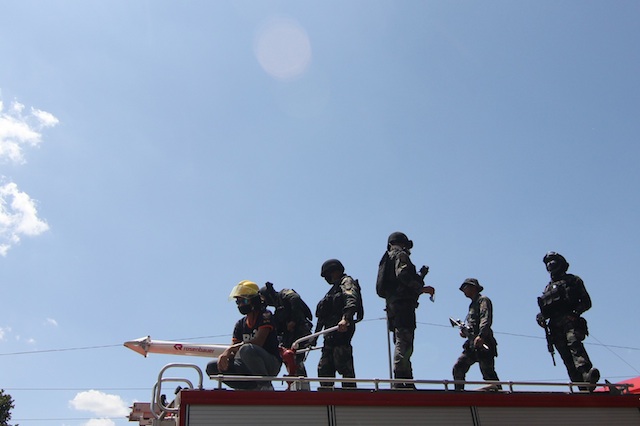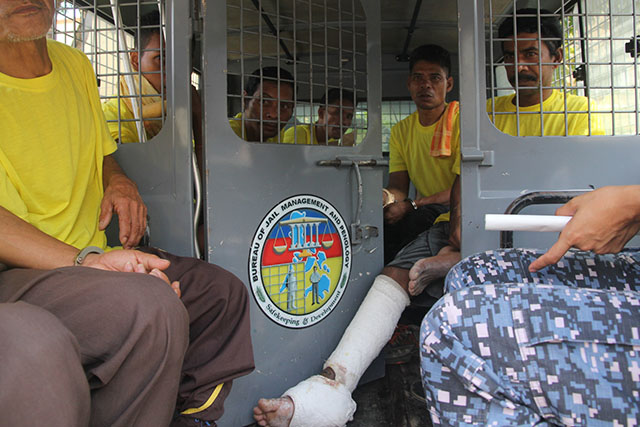Sixteen of 30 members of the armed unit of the Civil Disturbance Management (CDM) contingent that dispersed a three-day baricade in Kidapawan City on April 1 were found to have fired their guns, the police told the Senate Committee on Justice and Human Rights during the second round of its probe on Wednesday afternoon.
This as as forensic pathologist Dr. Raquel Fortun testified that two persons who were killed that day – farmer Darwin Sulang from Arakan town who joined the barricade and welder Enrico Fabligar from Kidapawan City who was just passing by – were felled by bullets.
Sr. Supt. Alejandro Gunao, chief of the Regional Crime Laboratory said 16 of 30 armed police tested positive in the paraffin test, to which Senator Aqulino Pimentel III, Committee chair, asked if “the conclusion is they fired their weapons?” Gunao said yes.

Members of SWAT (Special Weapons and Tactics) team on top of a firetruck in Kidapawan City on March 30, Day 1 of the barricade. MindaNews photo by TOTO LOZANO
The dispersal left two persons dead and scores of protesters, police and fire deparmetn personnel wounded. Some 5,000 farmers and members of militant organization had set up a barricade along the national highway in Kidapwan City on March 30 to demand, among others, the release of 15,000 sacks of rice for drought-stricken farmers.
Fortun said the paraffin test is “absolutely worthless” as it does not distinguish a shooter from a non-shooter, and this test has not been used by the Interpol since 1968.
Asked by Pimental what is the more reliable test, Fortun said a scanning electron microscope.
“Not from us”
Gunao confirmed the bullet taken from Fabligar’s body was turned over to them but not Sulang’s.
In the case of Fabligar, he said, the bullet used was from an M-16 armalite but he said the result of the ballistic exam showed “hindi galing sa bala ng PNP” (the bullet was not fired from the gun of the Philippine National Police).
“In that case, did any of your men during or before the dispersal see anyone brandishing an armalite?” asked Senator Tito Sotto.
Senior Supt. Alexander Tagum, provincial police chief who was relieved on April 5 pending investigation, said they have a witness who saw armed people among the protesters. But he did not respond to Sotto’s query if his men saw somebody brandishing an armalite.
Where are the Cabinet secretaries?
Senate Minority leader Juan Ponce Enrile who criticized the Committee two weeks ago
for holding an investigation “in aid of election” because there was no sufficient notice (he said he received the notice afternoon of April 6 for the hearing set for the morning of April 7 in Davao City), asked why Cabinet secretaries and the head of the Philippine National Police were not present at the hearing.
In the first round of the probe on April 7, the Cabinet secretaries summoned by the Senate Committee were not also present.
In Wednesday’s hearing, Enrile repeatedly asked if President Aquino “who has power of decision and action” was notified about the Kidapawan barricade.
He asked Sr. Supt. Alexander Tagum, the provincial police chief who was ordered relieved pending investiagation, “what impelled you to use bullets instead of something else?”
Tagum, who also testified during the first thearing on April 7 in Davao City, said he did not order his men to fire.
“Why did you use you firearms to fire at the protesters? Even under martial law we never did that, to fire at your people. A doctrine in the military is you cannot fire at civilians,” Enrile, Defense Minister under the Marcos dictatorship, said.
Enrile asked Tagum if they fired shots in the air but Tagum said “bawal sa batas mag fire ng warning shots” (the law prohibits the use of warning shots).
“You know, you never fire at a crowd. Never. That’s why during EDSA revolution we were sure the crowd won’t be fired at and it turned out that way,” Enrile said, adding, “evidently, you have a different doctrine now. Bullet for hunger, bullet for rice.”
Who killed who?
“For the record, I did not order my people to fire at the people,” Tagum replied, prompting Enrile to ask “you are saying the militants killed their own people?”
“That might be, Sir,” said Tagum, who also repeated what he said on April 7, that his CDM was unarmed but they had an armed security unit. The armed security unit reportedly numbered 30, and in the first Senate hearing, the Committee was told that all 30 members of that unit were subjected oto paraffin test, 16 of whom tested positive and 14 negative.
“Pinakalumang storya na po yang may baril sa raliyista. Panahon pa ni Marcos [That rallyists have guns is an old story used by the police, since the time of (former President Ferdinand) Marcos], said Atty. Efraim Cortez of the National Union of Peoples Laywers (NUPL).
Cortez also said the police immediately destroyed potential evidence at the crime scene.
The police later presented a witness, named Charlie Pasco, who claimed to be a former member of the New Peoples’ Army (NPA) and now an asset of the Army’s 39th Infantry Battalion since he surrendered in 2014.
Pasco said he infiltrated the ranks of the protersters at Spottswood Methodist Mission Center and the barricade and met some of his former comrades, including Sulang, who he said was armed with a caliber .38 revolver. Pasco had earlier claimed Sulang left the NPA much earlier than he did.
He said it was not only Sulang who was armed but several others. He did not say how many armed people and he claimed he could not identify what firearms they were using.
He said on April 1, shortly after 10 a.m. when the police and protesters were negotiating, when firetrucks were starting to blow their siren and the stonethrowing started, he saw Sulang fire his gun. From behind him, there was intermittent firing allegedy coming from the side of the Methodist compound, he claimed. He said he saw Sulang lying on the ground.
Sulang’s father Ebao, a former member of the CAFGU (Citizens Armed Forces Geographical Unit) who also testified at the hearing, denied his son was an NPA member.
Gunshot wounds
Dr. Fortun who performed an autopsy on Sulang told the Senate Committee that Sulang “sustained a gunshot wound at the head, entrance wound is almost at the center of the forehead slightly to the right, exit was at the top of the head” and that the trajectory was “upward and backward.”
“He had extensive fractures of the forehead, top and sides of the head… some injuries in the brain consistent with gunshot wound,” Fortun said.
Sulang’s death certificate issued on April 4 said the immediate cause of his death was “cardiorespiratory arrest secondary to head injury due to mauling and the antecedent cause was “avulsed wound at occipital areaea, punctured wounds at frontal area.”
On April 7, however, at the Senate hearing, an officer of the Scene of the Crime Operatives (SOCO) testified the cause was gunshot wound.
Fortun said Fabligar had only one inury on the right side of the body and that bullet was recovered on the left side of the body, on the chest.”

Detained farmer Arnel Takyawan tries to stretch his leg while waiting for their supposed arraignment at the Hall of Justice in Kidapawan City on April 14, 2015. The arraignment was deferred as lawyers questioned the validity of the arrest. Takyawan was hit by a bullet during a violent dispersal of a protest rally last April 1. He was among 81 charged with “direct asssault.”. MindaNews photo by TOTO LOZANO
She said she examined the body and saw sutured injuries on one side and on the other side sutured post mortem inspection and was told by the mortuary assistant who also assisted her that she was the one who made the incision as directed by the City Health Officer “and they recovered the bullet and turned it over ot the SOCO.
She said the trajectory of the bullet was “right to left upward and forward.”
“I can only speculate as to internal injuries. I think he must have bled massively inside,” she said.
Farmer Arnel Takyawan of Antipas town, testified that from a 30-meter distance, he saw a member of the SWAT (Special Weapons and Tactics), aiming at him but in the first attempt, the policeman missed but when he moved back, his leg was hit.
http://www.mindanews.com/top-stories/2016/04/20/16-of-30-armed-police-fired-their-guns-in-kidapawan-dispersal/

No comments:
Post a Comment
Note: Only a member of this blog may post a comment.